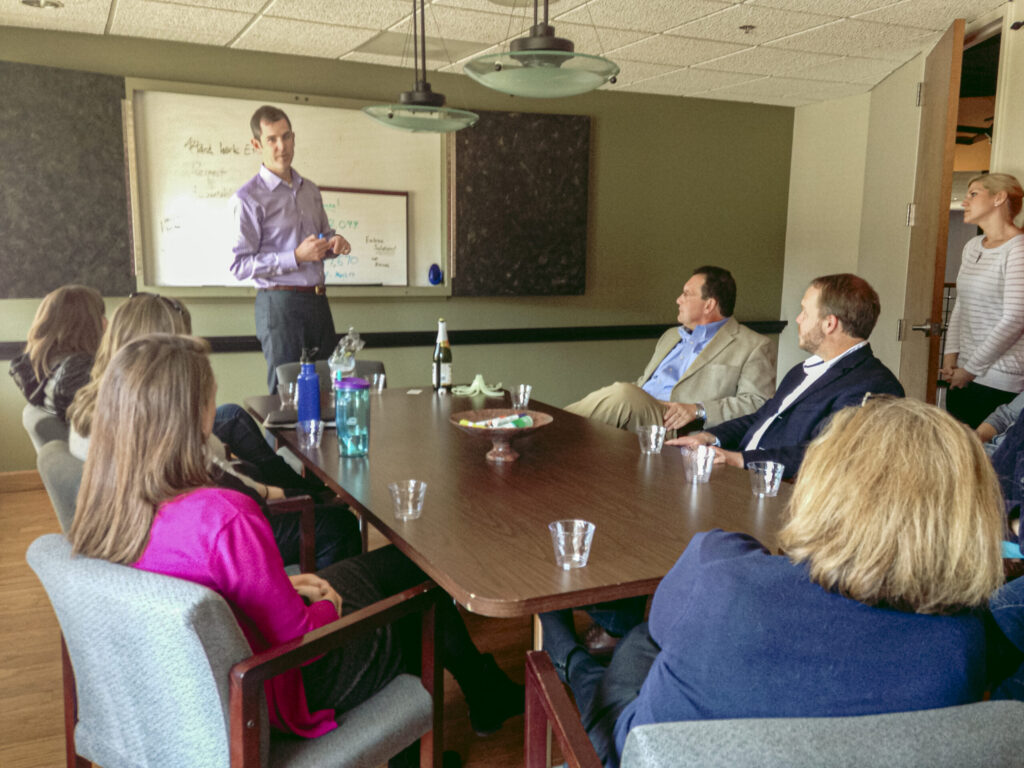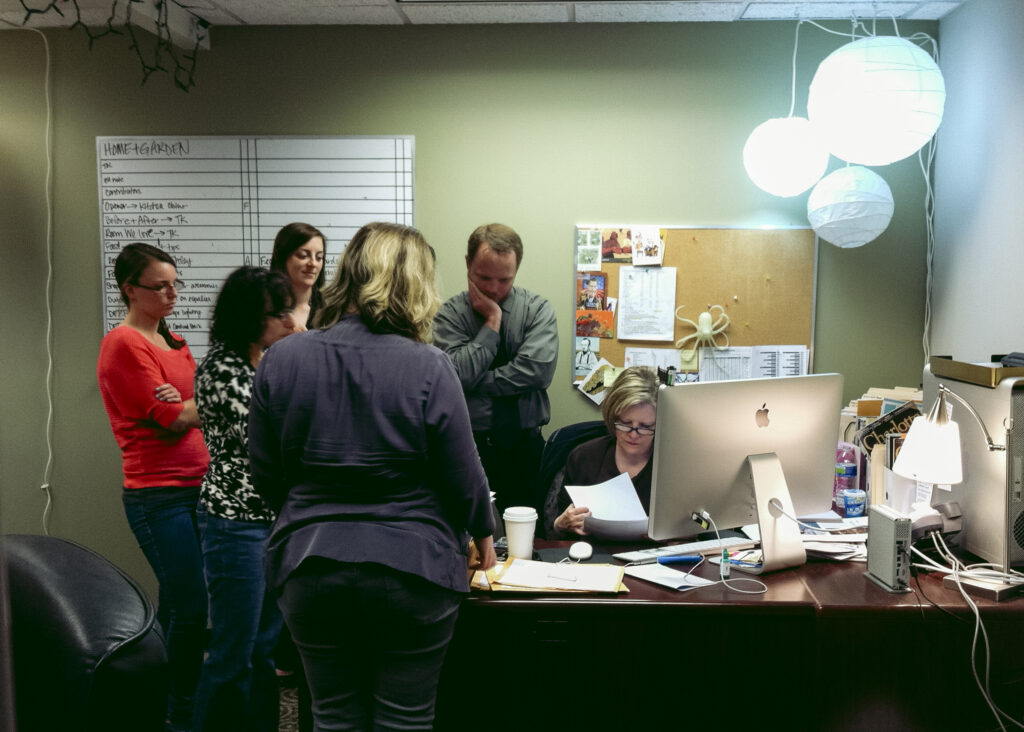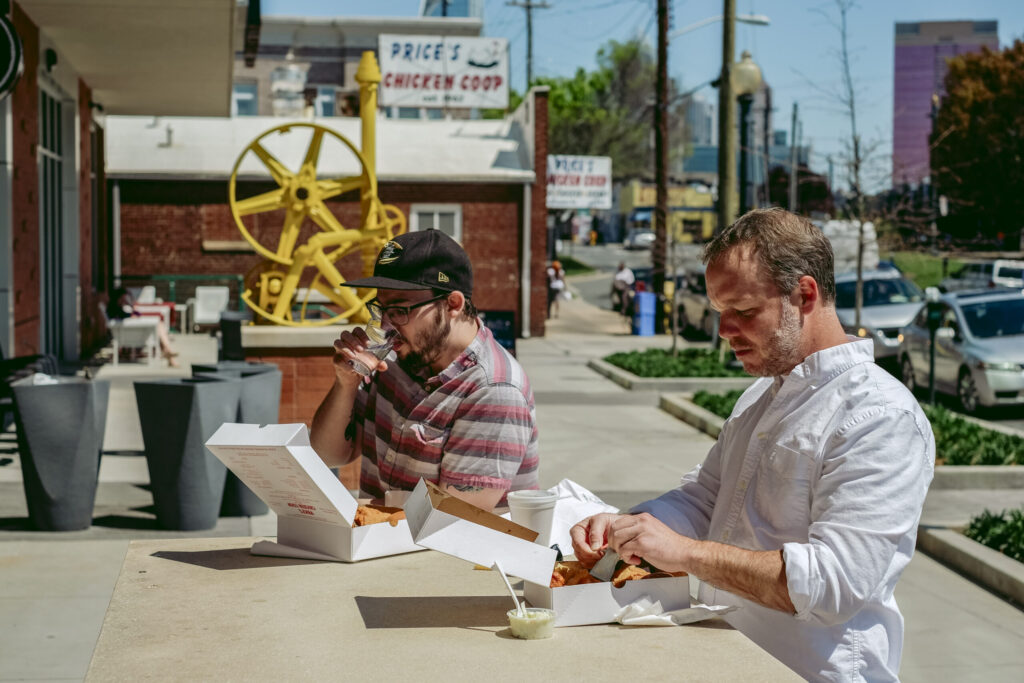The morning after our wedding, as sunlight came through our uptown hotel window, I asked Laura to open Charlotte magazine’s website. Romantic, I know! But it was the first of October, and my monthly column would be posted that morning. I’d written it as a surprise to her, titled, “A Letter to My Wife.”
“I hate to tell you this a day late,” it read, “but I’m getting the better end of the deal here, you know?”
I’m lucky to have lots of uneven relationships like that in Charlotte. The city’s given me more than I can give back, and she’s at the top of that list.
Right below her, though, is Rick Thurmond. He hired me to be Charlotte magazine’s editor in early 2013, and then I fell in love here — first with the city, then with the magazine, then with Laura, then with our children — and none of that would have happened if Rick hadn’t brought me here.
Which made it all the more painful this past Thursday morning when I called him to see if he’d heard the news: Charlotte magazine was closing.
Some executives at Morris Media Group in Georgia had decided to kill it. Why is unclear. The magazine still retained a steady ad base, mostly through the sheer will and warmth of publisher Andy Smith.
I’d learned the night before, when editor Greg Lacour called to tell me I didn’t need to rush to write the essay I’d planned to co-publish with them in their February issue. A shame. It would’ve been a good one. I was paired up with Jen McGivney and Tommy Tomlinson. Our topic was broad, but the issue would be titled, “The Connections Issue.” The irony is so obvious it’s gross: An issue about connections, chopped.
Few relationships are as out of balance as distant owners of a beloved local institution. To them the magazine is a “title” in a portfolio, a taxidermied head on a wall. To the people who cared for it over 57 years, though, and to the city whose narrative the magazine helped curate, it’s far more. Charlotte magazine was and is the best serial collection of our city’s story over the past half-century.
Testimonials have poured in since the Charlotte Ledger broke the news Thursday. Tommy wrote his own tribute in his newsletter, as did the great Jeremy Markovich. I’m glad they did; it saves me a few words about them here. The eulogies confirm what we often preached: Spreadsheets can’t measure passion. Subscription numbers and pageviews are insufficient thermometers of how much something matters.
Charlotte magazine matters. Or it mattered, I guess. It was bold yet modest, celebrated yet overlooked, much like our city when it’s at its best. In an age of doomscrolling and rage-baiting, that’s worth remembering.


Before one of my first staff meetings as editor, I got in early and wrote one word on a whiteboard: “Indispensable.”
Our team spent two hours talking about how we should always strive to make the magazine that to our readers. At the time, 2013, most publications boasted about audience numbers. But we wanted a relationship. We wanted the magazine to feel like family. We’d rather have one person spend an hour with the magazine than have 60 people spend one minute with it.
We made it personal. We set ridiculous principles for a journalism outlet: 1. Be a good person first, before even being a good journalist. 2. Treat the people in your stories the way you’d want your own story to be treated.
I spent thousands of my own dollars taking writers out to coffees and drinks, never expensing any of it, to save money in our budget to pay them (slightly) better commissions. Rick told me to stop doing that, I should say. But it always felt like an investment that I’d make back one day, somehow.
You know what happened. I did. Most of those people wound up reinvesting their time and treasure in Charlotte, and still do. If you attend any civic gathering today, you’re likely to bump into someone who worked for or with the magazine, in some capacity.
Rick’s now the the chief marketing officer for Center City Partners. Former associate editor Adam Rhew is CEO of SouthPark Community Partners. Former senior editor Kristen Wile founded Unpretentious Palate. Former senior editor Sarah Crosland is now a vice president of Compass Group. Former intern-turned-editor Emma Way now is an associate director at Axios. Former marketing director Casey Wilson, who turned the annual “BOBs party” into the annual place to see and be seen, now has her own events company. Sarah Walker, one of the magazine’s best salespeople, now works with another humble Charlotte legend, Laura Vinroot Poole, at Capitol.
It’s dangerous to start naming people, because I’m sure to miss someone. But you get the point. Charlotte leaders like Michael Marsicano and Hugh McColl have long told me that this is a city built on reciprocity. Charlotte magazine embodied that. People came through those pages and became better Charlotteans.
Some did go on to bigger places. Freelancer Mike Giglio became a staff writer for the Atlantic. Michael Kruse, who wrote some of the first longform features on some guy named Stephen Curry, way back in 2007 for Charlotte magazine, is a longtime senior writer at POLITICO. Jarvis Holliday, who now lives in Atlanta, published the ridiculously popular “Dusk Till Dawn” blog for the magazine’s website. It was a list of nightlife events, and it was a prelude to the “things to do” market that Charlotte Agenda later owned.
Individual stories went on to live larger lives, too. Rick commissioned a narrative feature on the Loomis Fargo bank heist in Gastonia, and that later became a Hollywood film Masterminds, starring Zach Galifianakis. He edited the definitive story of Charlie Sifford, before Sifford won the Medal of Freedom.
Jesse Soloff spilled his heart on the page in an essay about his late wife, Taylor, and it not only won a national award, it later helped connect him with his future wife, Katie Peralta. Charlotte native David Joy wrote a handful of pieces for the magazine, and one of his unrelated novels recently became a Hollywood film. And Patrice Gopo’s essay, “That Autumn,” won a national award as the best essay in the country that year.
The legacy goes back long before that. Pat Conroy was a contributing editor in the 1970s. Yes, that Pat Conroy. In fact, his first essay for the mag, published in 1976, was the story behind the story of his bestseller The Great Santini. Only two copies of that essay still exist, that I know of — one in the Charlotte magazine archives, and one in the Robinson-Spangler collection at the Charlotte-Mecklenburg Library.
Thankfully, the Charlotte Museum of History called the magazine on Friday and offered to preserve the office archives. A nice gesture, and another sign of the magazine’s importance in our city’s history.


The stories behind the stories were sometimes more interesting than what we printed. Adam Rhew once went on a run with former Panthers’ wideout Steve Smith, and about a mile from the finish line Smith inadvertently blurted out that he planned to retire that offseason. We sat on that news for three months, until the story ran.
Another one: In 2013, we somehow convinced former Hornets owner George Shinn and legend Muggsy Bogues to stop by our office for a photo shoot, to celebrate the 25th anniversary of the 1988 Hornets. Matt Crossman had written a brilliant oral history of the team and how it came to be, and we aimed high for the art, too.
When Muggsy and George saw each other, they hugged. Then Muggsy whispered something to our staff that we couldn’t believe: It was the first time they’d seen each other since a falling-out over Shinn’s controversial decision to move the team to New Orleans.
That November, when Shinn threw a party for the anniversary, and several former players showed up, he walked up to me and said, “Your magazine made this possible.”
Yeah, Charlotte magazine mattered.
Still, maybe the best success story stayed in house, all the way to the end.
In April 2013, Rick handed me a resume for Andy Smith, a kid out of West Virginia who’d moved here without a job. He said he’d do anything the magazine asked of him. I gave him a few fact-checking assignments, then a few more, and then we made him our part-time arts writer. He climbed and climbed, all because of his talent, loyalty, and work ethic.
Today Andy’s the publisher. To say he’s taking this news hard is an understatement. So I want to clear something up for him, and Charlotte: You ran a damn good race, Andy. So did editor Greg Lacour and lifestyle editor Taylor Bowler. And so, especially, did lead designer Jane Fields, who worked there for 13 years. All good people, looking for jobs. Consider this my letter of recommendation.
Put it this way: Every success Charlotte magazine had, every connection it deepened in this city, happened because of the people here, and because of Charlotte. The company in Georgia may retain the brand and dictate its future, but they always missed the meaning.


The other night I went back through my first emails from Rick, back when he interviewed me for the job. I’d asked him a bunch of boring questions when he offered: Could I still freelance elsewhere? Did they have 401(k)?
He answered yes to those, but then said something most new bosses wouldn’t say, and even fewer would follow through on: I won’t micromanage you.
He never did. He empowered me in ways no other publication or editor ever had, almost to a fault. Whenever I presented him with a challenge, he’d deliver his most annoyingly helpful line — “I look forward to seeing what you come up with!” — and walk out of the room. What an ass.
But in reading those first emails from him, I noticed a postscript, and it hits a little different a dozen years later.
“P.S. – I don’t know how much time you’ve spent here, but Charlotte is a good place.”
That was his final sales pitch. Not journalism. Not benefits. Not salary. Just, Charlotte. I wrote him back and said, “Yes.”
From there we spent hours talking to each other, about the city and life. He was the first person I called when I was going through a breakup, and that night he took me out for a drink at Thomas Street Tavern. He seemed worried I would leave for another job in another city, but instead of asking me that question directly, he asked what I wanted out of life.
I was 35 years old. I’d fallen in love with Charlotte. And I wanted to stay. Somehow the conversation shifted to family, and for some reason he said something I’ll never forget, in a booth on the far wall of the bar, “I think you’d be a fantastic father one day.”
I thought of that conversation in March of 2020 and in March of 2023, when Laura gave birth to our boys.
Yeah, it was more than a magazine.
And when we were good, the city was better.
I pulled all my old issues out of the attic on Friday and laid them on the ground. We had months about happiness, love, solutions.
I peeled through stories I’d written: the greatest female skydiver of all-time, Myers Park High’s 2015 football team, the McCrorey Heights neighborhood, a rose garden in Elizabeth, Dot Counts-Scoggins, the death of the original South End Common Market. Once, I wrote about how I define success, and Reader’s Digest called and paid me to reprint it. Another time I wrote about being the only writer on a beer-league softball team with my brother’s construction company, and that story somehow landed in the Best American Sports Writing.
But without question, the most popular piece I ever wrote was an editor’s note on a writer who submitted a story for the magazine, went through edits for it, but died between the time we sent it to the printer and when it delivered. The New York Times picked that one up in their morning newsletter, and I heard from people around the world.
Flip, flip, I went. Through the story of Charlotte, through the stories of my life, and suddenly I was crying.
Over paper.


Last thing.
Each December, beginning in 2014, we published a Charlotteans of the Year issue, a tribute to people who’d made Charlotte a better place that year. As it happens, the 2025 COTY issue will be the final issue of the magazine.
Back then, I worked closely with the writers and got to know most of the winners each year. Several remain in my inner circle of friends.
The first issue holds a special place. That year, Garinger teacher James Ford graced the cover. He was North Carolina’s teacher of the year that year. He wore a bowtie to the photo shoot, and shared his soul with writer Matt Crossman. James went on to the state board of education, shaping curriculum for children statewide, and founded his own nonprofit.
We stayed in close contact afterward. We’re the same age, and we share similar temperaments and ways of thinking about the world. He’s a dear friend to this day. He was one of the first people to reach out to me when my father died; I did the same for him when his passed several years later. Reciprocity, or something.
In the summer of 2017, I told James that Laura and I were engaged. He looked at her and joked, “I’m so happy. Because if you don’t marry Michael, I’m gonna!”
It made for a good laugh. But two weeks later, the minister who planned to officiate our wedding passed away. I came up with an idea and Laura went along with it. I called James and asked him to officiate. He said he’d be honored.
And on the last day of September that year, at the Mint Museum Randolph, Charlotte magazine’s first Charlottean of the Year pronounced us husband and wife, and then we celebrated and went off to a hotel room in uptown.
The next morning, we read Charlotte magazine together at sunrise.
Editor’s note: We corrected this story to show that Taylor Bowler’s title is lifestyle editor.



